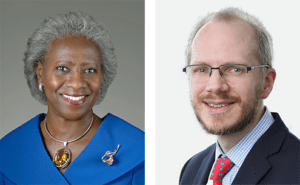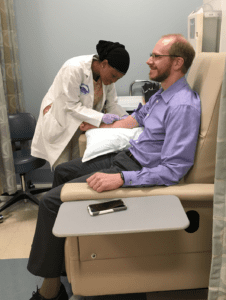June 2020

ASHG is committed to supporting diversity and inclusion initiatives in genetics research and building a scientific community that is welcoming to all. Genetic studies have largely focused on populations of European descent, and more work is needed to create diverse reference datasets. These tools can help to aid precision medicine discoveries for all patients. ASHG spoke with NIH senior leadership to learn more about current initiatives to create a diverse and inclusive research community.
We first spoke with Hannah Valantine, MD, MCRP, Senior Investigator of Transplantation Genomics at the National Heart, Lung, and Blood Institute (NHLBI); and Chief of the NIH Office of Scientific Workforce Diversity.
ASHG: We believe that diversity, equity, and inclusion in research is a scientific and community imperative, as outlined in our Diversity & Inclusion Policy released in January. Why are these values so important for the scientific workforce?
Dr. Valantine: We know that diversity of perspective is clinically important for research. It broadens the research questions being asked and increases the likelihood of finding better, more innovative solutions. This is especially true when studying complex topics like health disparities and differences in health outcomes.
In cardiology, for example, when more women got into the field, they began investigating more questions about how heart disease progresses in women. This led to a better understanding of disease and better care for women.
Diversity and inclusion programs are also important given the changing demographics of the United States. In some states, underrepresented groups now make up the majority of the population. Programs that promote diversity help to recruit the most talented individuals across backgrounds into the sciences.
ASHG: You are NIH’s first-ever Chief Officer of Scientific Workforce Diversity. What are some of NIH’s key programs and priorities in this area?
Dr. Valantine: In January, we approved the new Faculty for Institutional Recruitment for Sustainable Transformation (FIRST) program, which will support roughly 120 newly hired young faculty members working in emerging areas of research. This program brings together cohorts of pre-tenure faculty who have an interest in diversity to support one another, navigate shared challenges together, share resources, and facilitate change across their home institutions.
This program emphasizes creating institutional change, because institutions are positioned to do so much to advance diversity and inclusion. We encourage institutions to take a coordinated approach, involving:
- Collecting data from departments in a systematic, centralized, and transparent way
- Identifying and encouraging best practices for achieving diversity in search committees
- Tying results to the university-based reward system, especially the tenure system
We hope that programs like ours will help institutions realize greater equity across career stages, including at the leadership level. For example, recent data shows that 43% of tenure-track faculty across the U.S. are women, while less than 20% of departments are chaired by women. Some institutions have addressed these gaps and achieved greater equality, which speaks to the importance of culture change and creating value in bridging gaps among groups.
Next, we spoke with Joshua Denny, MD, MS, the Chief Executive Officer of the All of Us Research Program. All of Us is a national program to recruit 1 million Americans from all backgrounds to build one of the most diverse genetic databases in history. For more on the All of Us Research Program, watch our on-demand webinar on “Genomic Medicine at the Population Level.”
ASHG: How is All of Us working toward the creation of a diverse and inclusive research program?
JD: We aim to make our program open to all—that’s one of our core values. So we’ve teamed up with a diverse set of partners that lead national and local engagement efforts. We also involve participants at all levels of our governance to give us input. Just two years out from our national launch, more than 270,000 participants have completed our initial protocol, and more than 75% are from underrepresented communities. For us, that’s not just good for science, but the right thing to do. We want to enable discoveries that benefit all of us.
ASHG: What makes All of Us different from any other biobank resource?
JD: A few things make All of Us unique. Not only do we have one of the most diverse cohorts, but we’re also building it at scale—on our way to one million participants nationwide. We’re integrating multiple data types to achieve a depth of data over time, with surveys, electronic health records, biosamples, data from wearable devices, and eventually genomics and linkages to other datasets. We’re making all of this accessible to researchers on a central platform, which will enable easier collaboration across teams. We have created a “passport” data access model for researchers to simplify the process of accessing and doing science on the platform. We hope this model will become a paradigm for other research projects.
For our participants, a key differentiator of our program is that we will return information (including some genetic results for those who want them) as a benefit of participation. That has not been done before by a research program of our size and diversity.
ASHG: What are the most important factors to consider when reaching out to partners and participants?
JD: We’ve had to get really clear about our value proposition. What do our communities want and need, and how can All of Us help meet those needs? Answering that involves listening to people and understanding where they’re coming from. Communities have different histories and points of view about medical research; we have to be aware of the sensitivities and transparent about what we want to do. Not everyone, nor every community value the same things in the same ways, and you have to be sensitive to differing values and methods of approach.
It’s also important going in to recognize that engagement isn’t a one-time thing; it’s about building relationships and earning trust over the long term. That takes an ongoing investment in time and resources, as well as an openness to adapt as we get feedback from our partners. We want All of Us to be a program that communities build with us.
ASHG: What steps have you taken to engage both participants and researchers from underrepresented backgrounds in the project?
JD: We’ve built a national network of medical centers, community organizations, and other partners that are helping raise awareness about the program and encourage enrollment. They are trusted voices in their communities and lead grassroots outreach with materials tailored to their populations. We also support extensive digital outreach, educational efforts led by public libraries, and a traveling exhibit, the All of Us Journey, to extend our reach.
In terms of researcher engagement, our plans include workshops and user studies with a diverse set of researcher communities, including citizen scientists, and direct outreach to minority-serving institutions.

ASHG: How can scientists learn from All of Us to make their own research more inclusive?
JD: I think researchers want to be inclusive with their research, but often face resource challenges with recruitment and retention of diverse populations at scale. Our hope by providing this central resource is that we’ll make it easier for more researchers to do analyses with diverse samples using data we’ve already gathered and curated. And down the road, researchers will be able to work with the program to recontact participants about other studies.
Beyond that, I can’t overstate the importance of involving participants and community groups from the outset in discussions about research and engagement plans. We learn so much from these conversations, and our program is better for it.
I’d encourage everyone to visit our website, ResearchAllofUs.org, for details and to subscribe for updates. We’re excited for the program to enter this new phase and eager for input from the researcher community!
Thank you, Drs. Valantine and Denny for your perspectives. Researchers at every institution can learn from your efforts to create an environment welcoming to diverse researchers, patients, participants, and families.
